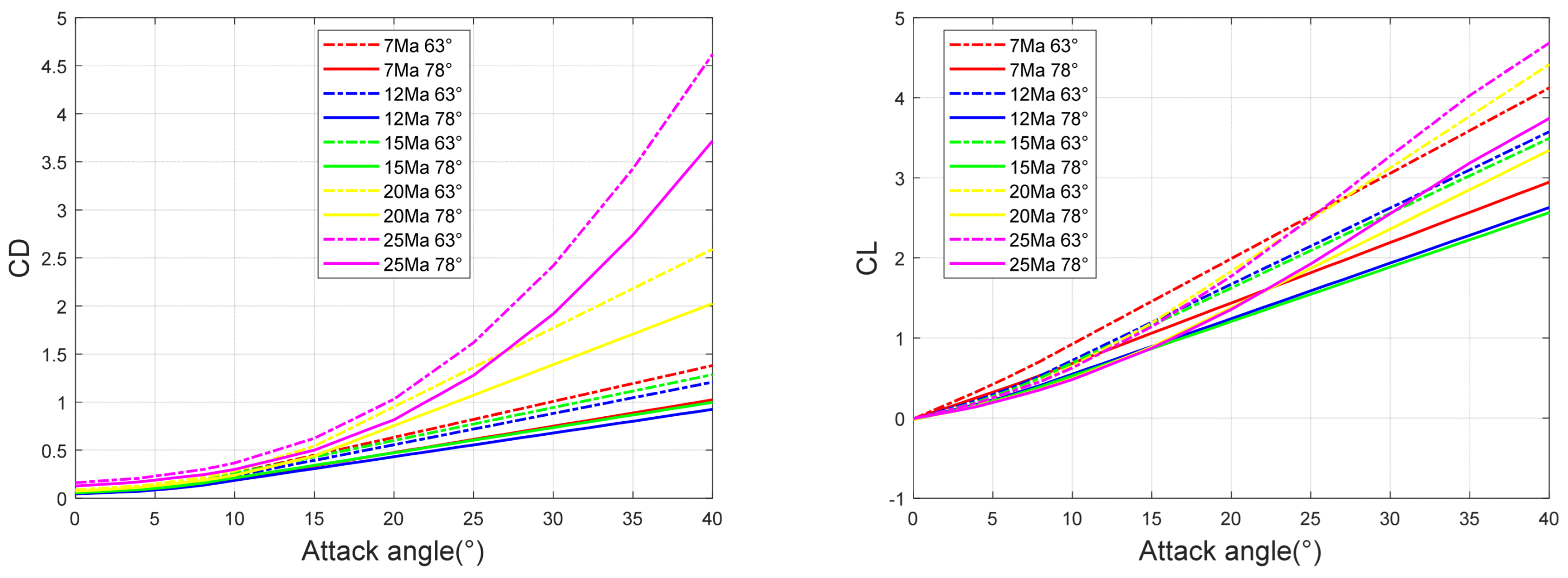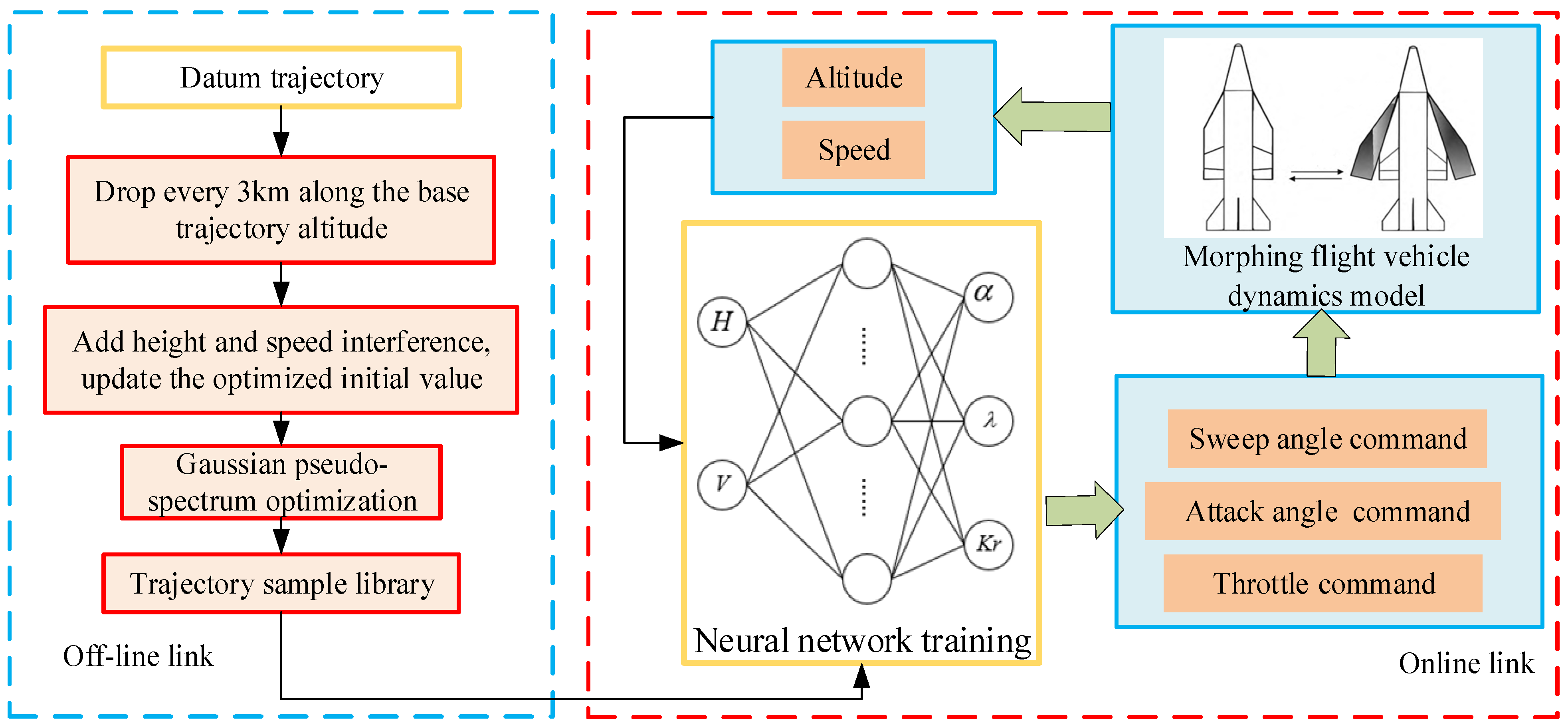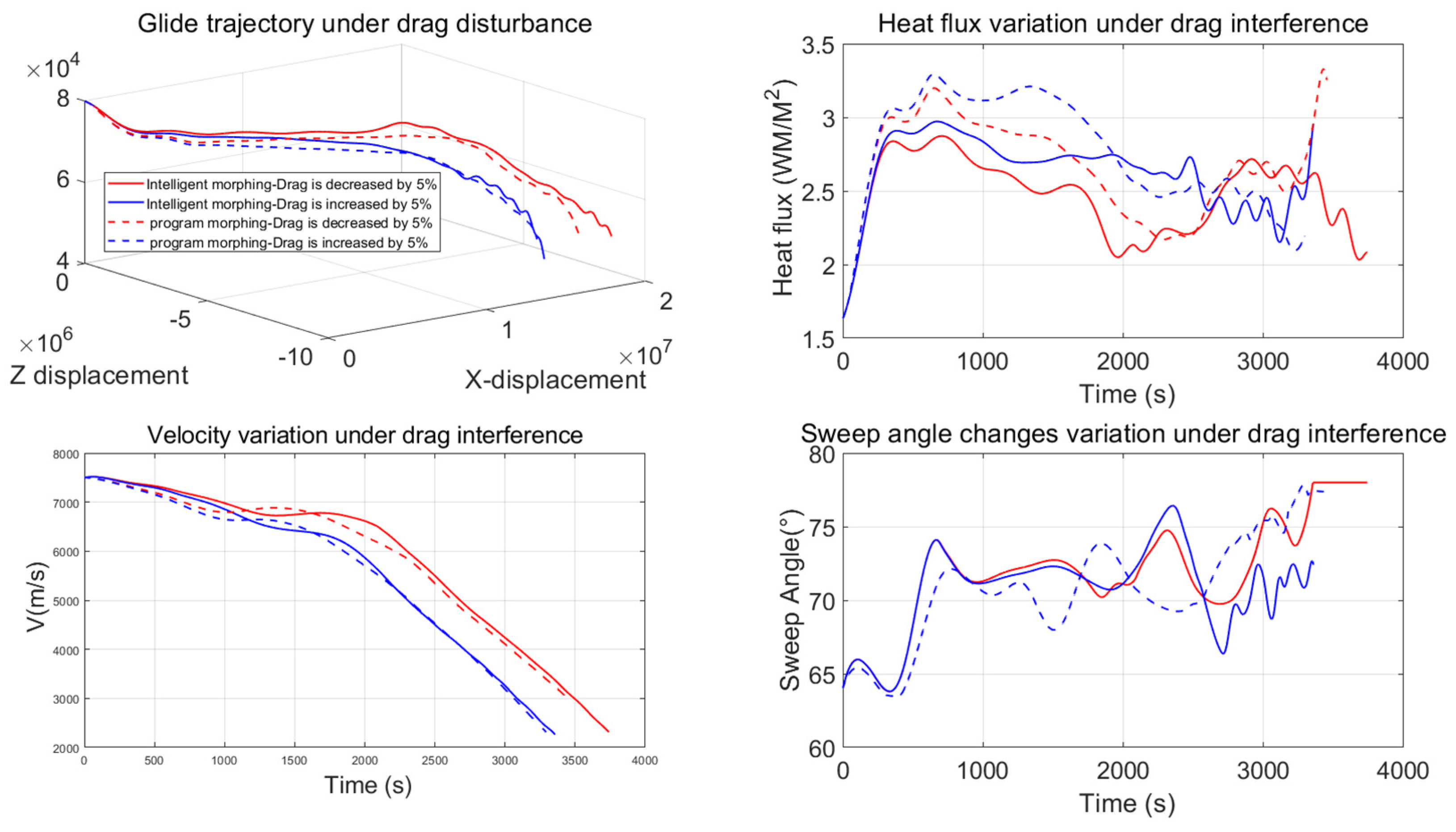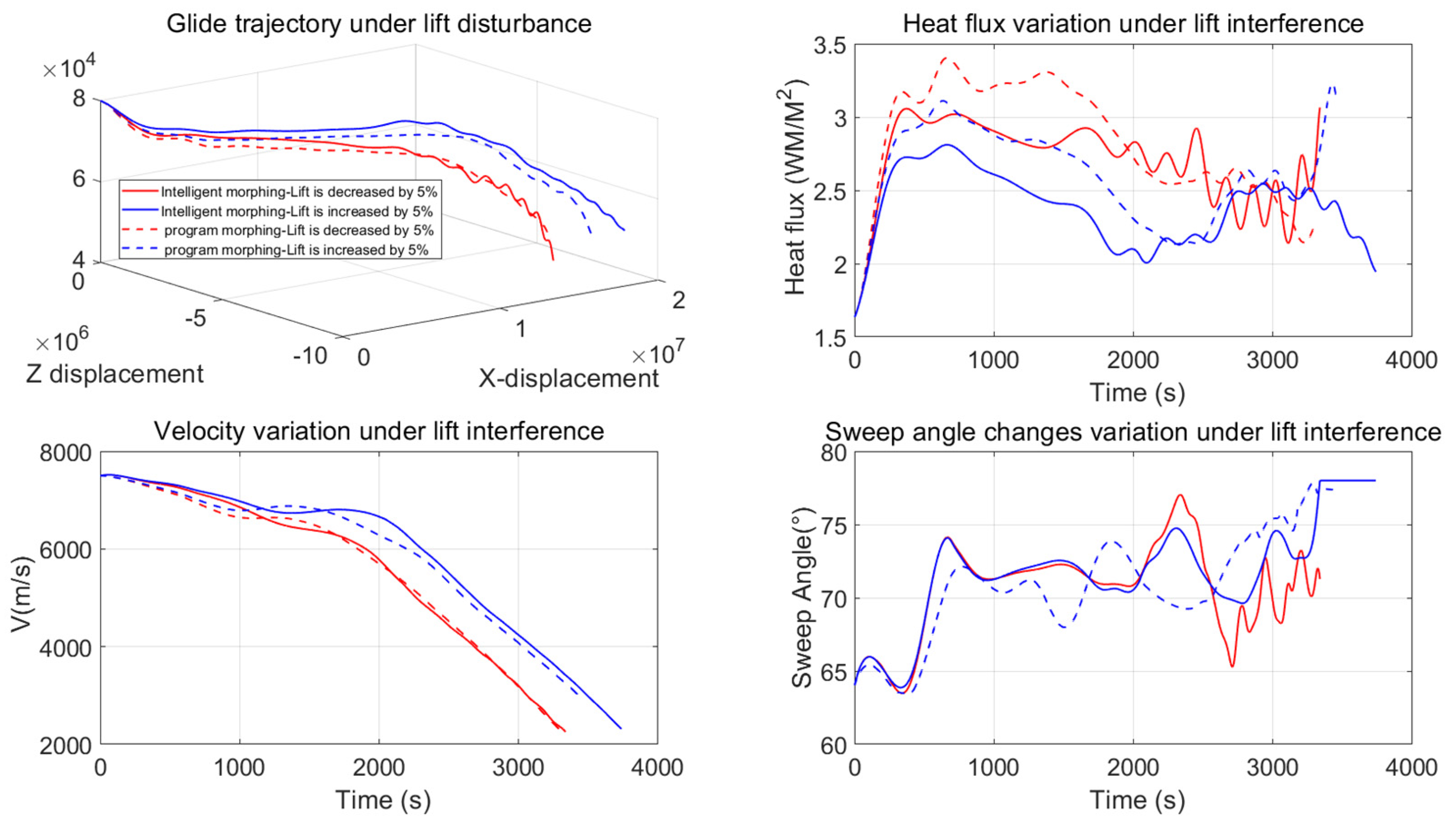An Intelligent Autonomous Morphing Decision Approach for Hypersonic Boost-Glide Vehicles Based on DNNs
Abstract
:1. Introduction
- (1)
- Compared with reinforcement learning, the Gaussian pseudo-spectrum method can obtain a continuous sequence of state quantities and control quantities while considering state constraints, giving full play to the full potential in the variable range of sweep angle.
- (2)
- Instead of fitting the sweep angle as a function of flight state quantity, a DNN essentially realizes a mapping function from input to output, which is suitable for solving problems with complex internal mechanisms. It can realize online rapid decision-making of the sweep angle according to flight status.
- (3)
- Compared with an ordinary glide vehicle, hypersonic boost-glide vehicles have additional propulsion systems and control dimensions.
2. Hypersonic Morphing Vehicle Dynamics Modeling
3. Intelligent Decision-Making Method Based on a DNN
3.1. Gaussian Pseudo-Spectral Principle
3.1.1. Time Domain Transformation
3.1.2. The Optimal Control Problem Is Parameterized to the NLP Problem
- State quantity discretization.
- Performance indicators discretization.
- Discretization of boundary conditions.
3.2. Segmentation Optimization Based on Gaussian Pseudo-Spectrum Method
- (1)
- Based on the optimized reference trajectory for entry conditions, height and velocity disturbances are applied to the hypersonic aircraft every 3 km, resulting in multiple entry conditions.
- (2)
- Based on the multi-group deviation entry conditions, the Gaussian pseudo-spectrum method is employed to optimize the trajectory multiple times. This process generates data pairs, consisting of the state quantity and the output quantity , at each moment. These data pairs are then used to construct a trajectory sample library.
- (3)
- Use the neural network to approximate the complex nonlinear model between the state quantity and the control quantity; that is, , where represents neural network approximation. Steps (1)~(3) are completed offline.
- (4)
- The neural network intelligent morphing decision-maker and the hypersonic vehicle motion model form a closed loop. The neural network decision-maker receives the flight state data, and output the sweep angle and other control quantities.
3.3. DNN Training Based on Trajectory Sample Database
3.3.1. Forward Propagation
3.3.2. Error Backpropagation
4. Hypersonic Vehicle Morphing Decision Simulation
4.1. Generation of Datum Trajectory and Interference Trajectory
4.2. Intelligent Morphing Decision and Instruction Morphing Decision Comparison Simulation
5. Conclusions
6. Limitations and Potential Future Directions
- (1)
- Integration of control methods: While this paper primarily concentrates on shape decision-making, it is crucial to acknowledge that shape changes can significantly impact the aircraft’s aerodynamic characteristics. Subsequent research should involve the design of advanced control methods, such as LPV control and adaptive control, to improve the tracking effect and enhance the morphing stability of the aircraft.
- (2)
- Conducting physical experiments: The research on hypersonic morphing vehicles in this paper is primarily based on simulation experiments. However, achieving favorable decision-making results in simulations does not guarantee the same effectiveness when implemented in practical engineering. Therefore, it is necessary for future research to construct physical models of hypersonic morphing vehicles and validate the designed decision-making system’s effectiveness on these models.
Author Contributions
Funding
Data Availability Statement
Conflicts of Interest
References
- Wang, C. Research status and Key Technology analysis of morphing aircraft. J. Dezhou Univ. 2019, 37, 31–34. [Google Scholar]
- Zhen, Z.; Liu, P.; Lu, Y. Research progress on intelligent morphing and flight control technology of morphing aircraft. J. Nanjing Univ. Aeronaut. Astronaut. 2022, 54, 995–1006. [Google Scholar]
- Peng, W.; Feng, Z.; Yang, T.; Zhang, B. Trajectory multi-objective optimization of hypersonic morphing aircraft based on variable sweep wing. In Proceedings of the 2018 3rd International Conference on Control and Robotics Engineering (ICCRE), Nagoya, Japan, 20–23 April 2018; pp. 65–69. [Google Scholar] [CrossRef]
- Gong, L.; Wang, Q.; Dong, C. Disturbance rejection control of morphing aircraft based on switched nonlinear systems. Nonlinear Dyn. 2019, 96, 975–995. [Google Scholar] [CrossRef]
- Wu, K.; Zhang, P.; Wu, H. A new control design for a morphing UAV based on disturbance observer and command filtered back stepping techniques. Sci. China Technol. Sci. 2019, 62, 1845–1853. [Google Scholar] [CrossRef]
- Bao, C.; Wang, P.; He, R.; Tang, G. Observer-based optimal control method combination with event-triggered strategy for hypersonic morphing vehicle. Aerosp. Sci. Technol. 2023, 136, 108219. [Google Scholar] [CrossRef]
- Chen, X.; Li, C.; Gong, C.; Gu, L.; Da Ronch, A. A study of morphing aircraft on morphing rules along trajectory. Chin. J. Aeronaut. 2021, 34, 232–243. [Google Scholar] [CrossRef]
- Li, R.; Wang, Q.; Liu, Y.; Dong, C. Morphing Strategy Design for UAV based on Prioritized Sweeping Reinforcement Learning. In Proceedings of the IECON 2020 The 46th Annual Conference of the IEEE Industrial Electronics Society, Singapore, 18–21 October 2020; pp. 2786–2791. [Google Scholar] [CrossRef]
- Dong, C.; Guo, Z.; Chen, X. Robust trajectory planning for hypersonic glide vehicle with parametric uncertainties. Math. Probl. Eng. 2021, 202, 3676810. [Google Scholar] [CrossRef]
- Yue, C.; Tang, S.; Guo, J.; Cai, Y.; Yu, Z. Rapid Optimization of Reentry trajectory of Hypersonic telescopic deformable Vehicle. Syst. Eng. Electron. 2019, 43, 2232–2243. [Google Scholar]
- Yue, C.; Tang, S.; Wang, X.; Jie, G. Reentry guidance Method for Hypersonic Telescopic deformable Vehicle. J. Beijing Univ. Aeronaut. Astronaut. 2021, 47, 1288–1298. [Google Scholar]
- Bao, C.; Wang, P.; Tang, G. Integrated method of guidance, control and morphing for hypersonic morphing vehicle in glide phase. Chin. J. Aeronaut. 2021, 34, 535–553. [Google Scholar] [CrossRef]
- Dai, P.; Yan, B.; Liu, R.; Liu, S.; Wang, M. Integrated morphing strategy and trajectory optimization of a morphing waverider and its online implementation based on the neural network. IEEE Access 2021, 9, 59383–59393. [Google Scholar] [CrossRef]
- Dai, P.; Yan, B.; Huang, W.; Zhen, Y.; Wang, M.; Liu, S. Design and aerodynamic performance analysis of a variable-sweepwing morphing waverider. Aerosp. Sci. Technol. Technol. 2020, 98, 105703. [Google Scholar] [CrossRef]
- Xia, W.; Wang, W.; Zhang, W. The Optimal Sweep Angle Design of a Morphing Firebee Drone in a Cruise Mission. In Proceedings of the 2021 33rd Chinese Control and Decision Conference (CCDC), Kunming, China, 22–24 May 2021; pp. 5472–5477. [Google Scholar]
- Ahmad, D.; Ajaj, R.M. Multiaxial mechanical characterization of latex skin for morphing wing application. Polym. Test. 2021, 106, 107408. [Google Scholar] [CrossRef]
- Heeb, R.M.; Dicker, M.; Woods, B.K.S. Design Space Exploration and Modelling of GATOR 3D Printed Morphing Skins. In Proceedings of the ASME 2022 Conference on Smart Materials, Adaptive Structures and Intelligent Systems, ASME 2022 Conference on Smart Materials, Adaptive Structures and Intelligent Systems, Dearborn, MI, USA, 12–14 September 2022; AMSE: Oak Ridge, TN, USA, 2022. V001T03A015. [Google Scholar]
- Blok, L.G.; Longana, M.L.; Yu, H.; Woods, B.K.S. An investigation into 3D printing of fibre reinforced thermoplastic composites. Addit. Manuf. 2018, 22, 176–186. [Google Scholar] [CrossRef]
- Ahmad, D.; Ajaj, R.M.; Amoozgar, M. Elastomer-based skins for morphing aircraft applications: Effect of biaxial strain rates and prestretch. Polym. Test. 2022, 113, 107655. [Google Scholar] [CrossRef]
- Ahmad, D.; Patra, K.; Hossain, M.; Kumar, A. Crack Propagation Behavior of Laterally Constrained Polymers Used as Dielectric Elastomers. Rubber Chem. Technol. 2021, 94, 476–493. [Google Scholar] [CrossRef]
- Bishay, P.L.; Aguilar, C. Parametric Study of a Composite Skin for a Twist-Morphing Wing. Aerospace 2021, 8, 259. [Google Scholar] [CrossRef]
- Schlup, A.; Bishay, P.; Mclennan, T.; Barajas, C.; Talebian, B.; Thatcher, G.; Flores, R.; Perez-Norwood, J.; Torres, C.; Kibret, K.; et al. MataMorph 2: A new experimental UAV with twist-morphing wings and camber-morphing tail stabilizers. In Proceedings of the AIAA Scitech 2021 Forum, Virtual Event, 11–15 & 19–21 January 2021. [Google Scholar]
- Bishay, P.L.; Finden, R.; Recinos, S.; Alas, C.; Lopez, E.; Aslanpour, D.; Flores, D.; Gonzalez, E. Development of an SMA-based Camber Morphing UAV Tail Core Design. Smart Mater. Struct. 2019, 28, 075024. [Google Scholar] [CrossRef]
- Valasek, J.; Tandale, M.D.; Rong, J. A Reinforcement Learning-Adaptive Control Architecture for Morphing. J. Aerosp. Comput. Inf. Commun. 2005, 2, 4. [Google Scholar] [CrossRef]
- Valasek, J.; Doebbler, J.; Tandale, M.D.; Meade, A.J. Improved adaptive–reinforcement learning control for morphing unmanned air vehicles. IEEE Trans. Syst. Man Cybern. Part B (Cybern.) 2008, 38, 1014–1020. [Google Scholar] [CrossRef]
- Xu, X.; Li, A.; Zhang, C.; Yao, C. Design of morphing UAV control System based on Q Learning. J. Northwestern Polytech. Univ. 2012, 30, 340–344. [Google Scholar]
- Yan, B.; Li, Y.; Dai, P.; Xing, M. Research on Adaptive morphing Strategy and Flight Control Method of morphing Aircraft based on Reinforcement Learning. J. Northwestern Polytech. Univ. 2019, 37, 656–663. [Google Scholar] [CrossRef]
- Goecks, V.G.; Leal, P.B.; White, T.; Valasek, J.; Hartl, D.J. Control of Morphing Wing Shapes with Deep Reinforcement Learning. In Proceedings of the 2018 AIAA Information Systems-AIAA Infotech @ Aerospace, Kissimmee, FL, USA, 8–12 January 2018. [Google Scholar]
- Xu, D.; Hui, Z.; Liu, Y.; Chen, G. Morphing control of a new bionic morphing UAV with deep reinforcement learning. Aerosp. Sci. Technol. 2019, 92, 232–243. [Google Scholar] [CrossRef]
- Wu, K. Research on Flight Control and Shape Decision of Morphing Aircraft; Hunan University: Changsha, China, 2021. [Google Scholar]
- Ma, W. Research on Modeling and Longitudinal Robust Control Method of Hypersonic Morphing Vehicle; National University of Defense Technology: Changsha, China, 2017. [Google Scholar]
- Ma, H.; Song, B.; Pei, Y.; Chen, Z. Efficiency Change of Control Surface of a Biomimetic Wing Morphing UAV. IEEE Access 2020, 8, 45627–45640. [Google Scholar] [CrossRef]
- Zheng, M. Variable Sweep Aircraft Morphing Process Modeling and Flight Control Design. Master’s Thesis, Nanjing University of Aeronautics and Astronautics, Nanjing, China, 2015. [Google Scholar]
- Xu, Y.; Yang, Y. Spacecraft from the rail optimization method based on the bionic intelligent algorithm. J. Command Inf. Syst. Technol. 2023, 14, 1–6. [Google Scholar] [CrossRef]
- Wang, J.; Zeng, Q. Design of neural network guidance controller based on Pseudo-spectrum Method. J. Ordnance Equip. Eng. 2019, 41, 77–83. [Google Scholar]
- Huang, X.; Huang, X.; Yang, B.; Li, S. Intelligent trajectory guidance algorithm for GEO space debris removal. Acta Astronaut. Sin. 2023, 44, 719–730. (In Chinese) [Google Scholar]
- Li, Z.; Sun, X.; Hu, C.; Liu, G.; He, B. Neural network based online predictive guidance for high lifting vehicles. Aerosp. Sci. Technol. 2018, 82–83, 149–160. [Google Scholar] [CrossRef]
- Shi, Y.; Wang, Z. Onboard generation of optimal trajectories for hypersonic vehicles using deep learning. J. Spacecr. Rocket. 2021, 58, 400–414. [Google Scholar] [CrossRef]
- Cheng, L.; Jiang, F.; Wang, Z.; Li, J. Multi-constrained real-time entry guidance using deep neural networks. IEEE Trans. Aerosp. Electron. Syst. 2020, 57, 325–340. [Google Scholar] [CrossRef]
- Ardashir; Sabzalian, M.H.; Castillo, O.; Sakthivel, R.; Fayez; El-Sousy, F.M.; Mobayen, S. Neural Networks and Learning Algorithms in MATLAB; Synthesis Lectures on Intelligent Technologies; Springer International AG: Cham, Switzerland, 2022. [Google Scholar]









| Intelligent Morphing Decision-Making Based on a DNN | |
|---|---|
| Generate trajectory sample | while Descend to terminal altitude if Follow the reference trajectory descend >3 km Add interference Update initial conditions Trajectory optimization end end |
| Neural network training | Input: Trajectory sample 1. The linear relation coefficient matrix W and deviation vector b of each hidden layer and output layer are initialized as a random value. 2. For iter from 1 to MAX 2.1 For i = 1 to m (a) Set the input to DNN to x (b) For i = 2… L, forward propagation computation (c) Calculate the output layer output by the loss function (d) For i = 2… L, backpropagate the error 2.2 For i = 2… L, update the and of layer l 2.3 If all of the changes in and are less than the threshold for stopping the iteration, the loop goes to step 3 3. The linear relation coefficient matrix W and bias vector b of each hidden layer and output layer are output. |
| Intelligent decision process | Input: V and H of the current state of the hypersonic vehicle Process: Intelligent decision-making computing Output: Sweep angle command Attack angle command Throttle command |
| Quantity of State | Initial Boundary Constraint | Terminal Boundary Constraint |
|---|---|---|
| Altitude (km) | 80 | 45 |
| Velocity (Ma) | 26.52 | 7 |
| X-direction displacement (km) | 0 | 18,000 |
| Y-direction displacement (km) | 0 | 8000 |
| Structure Name | Parameter Setting |
|---|---|
| Number of layers and number of neurons | [36,36,12] |
| Number of iterations | 1500 |
| Learning rate | 0.01 |
| Maximum number of failures | 12 |
| Target mean square error | 0.0004 |
| Attack Angle | Sweep Angle | Throttle Coefficient | |
|---|---|---|---|
| BP | 0.0262 | 0.0031 | 5.61 × 10−6 |
| DNN | 0.0085 | 6.28 × 10−4 | 3.12 × 10−6 |
| Lift Is Reduced by 5% | Lift Is Increased by 5% | Drag Reduced by 5% | Drag Increased by 5% | |
|---|---|---|---|---|
| Program morphing displacement (km) | 18,533 | 20,468 | 20,529 | 18,557 |
| Intelligent morphing displacement (km) | 18,733 | 21,708 | 21,686 | 18,914 |
Disclaimer/Publisher’s Note: The statements, opinions and data contained in all publications are solely those of the individual author(s) and contributor(s) and not of MDPI and/or the editor(s). MDPI and/or the editor(s) disclaim responsibility for any injury to people or property resulting from any ideas, methods, instructions or products referred to in the content. |
© 2023 by the authors. Licensee MDPI, Basel, Switzerland. This article is an open access article distributed under the terms and conditions of the Creative Commons Attribution (CC BY) license (https://creativecommons.org/licenses/by/4.0/).
Share and Cite
Hou, L.; Liu, H.; Yang, T.; An, S.; Wang, R. An Intelligent Autonomous Morphing Decision Approach for Hypersonic Boost-Glide Vehicles Based on DNNs. Aerospace 2023, 10, 1008. https://doi.org/10.3390/aerospace10121008
Hou L, Liu H, Yang T, An S, Wang R. An Intelligent Autonomous Morphing Decision Approach for Hypersonic Boost-Glide Vehicles Based on DNNs. Aerospace. 2023; 10(12):1008. https://doi.org/10.3390/aerospace10121008
Chicago/Turabian StyleHou, Linfei, Honglin Liu, Ting Yang, Shuaibin An, and Rui Wang. 2023. "An Intelligent Autonomous Morphing Decision Approach for Hypersonic Boost-Glide Vehicles Based on DNNs" Aerospace 10, no. 12: 1008. https://doi.org/10.3390/aerospace10121008
APA StyleHou, L., Liu, H., Yang, T., An, S., & Wang, R. (2023). An Intelligent Autonomous Morphing Decision Approach for Hypersonic Boost-Glide Vehicles Based on DNNs. Aerospace, 10(12), 1008. https://doi.org/10.3390/aerospace10121008





